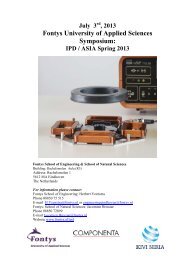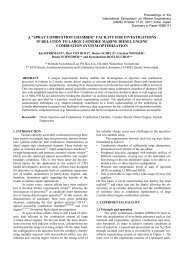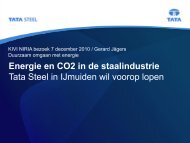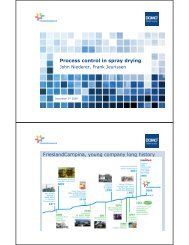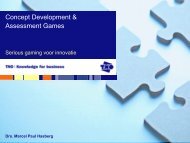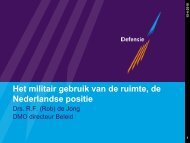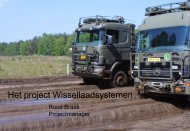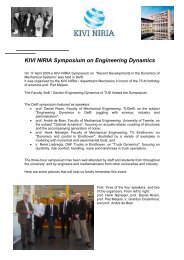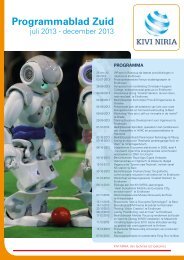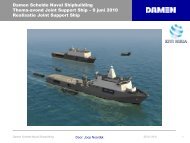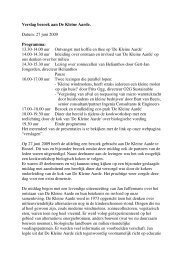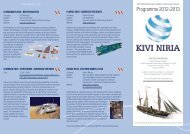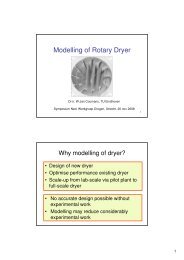The Fluidized Catalytic Cracking Process 65 years of ... - kivi niria
The Fluidized Catalytic Cracking Process 65 years of ... - kivi niria
The Fluidized Catalytic Cracking Process 65 years of ... - kivi niria
Create successful ePaper yourself
Turn your PDF publications into a flip-book with our unique Google optimized e-Paper software.
Shell Global Solutions<br />
<strong>The</strong> <strong>Fluidized</strong> <strong>Catalytic</strong> <strong>Cracking</strong> <strong>Process</strong><br />
<strong>65</strong> <strong>years</strong> <strong>of</strong> inspiration for technology development<br />
Mart Nieskens<br />
Presentation to KIVI - NIRIA<br />
October 4 th 2007
Shell Global Solutions<br />
2<br />
A 1990 presentation updated with a decade <strong>of</strong> developments
3<br />
Implementation<br />
Operation<br />
Shell Global Solutions<br />
Troubleshooting/<br />
Inspection<br />
Design<br />
Subject <strong>of</strong> this<br />
presentation<br />
Improvement<br />
R&D
SIMPLIFIED REFINERY FLOW SCHEME<br />
LPG<br />
HYDROSKIMMER<br />
Crude<br />
Crude<br />
Distilling<br />
Unit<br />
Naphtha<br />
Kero/Gasoil<br />
Hydro<br />
Treater<br />
Long Residue (LR)<br />
Platformer<br />
Hydro<br />
Desulph.<br />
Unit<br />
LPG<br />
Mogas<br />
Kero<br />
Gasoil<br />
Fuel Oil<br />
High<br />
Vacuum<br />
Unit<br />
Flashed<br />
Distillate<br />
Short Residue (SR)<br />
-<br />
Cat Cracker<br />
Hydro<br />
Desulph.<br />
Unit<br />
Gasoil<br />
COMPLEX<br />
Shell Global Solutions<br />
4
Residue Upgrade<br />
(>370 o C) in relation to<br />
FCC process ability<br />
Shell Global Solutions<br />
5
FLUID CAT. CRACKING UNIT (FCCU)<br />
Pres., barg Temp., C<br />
Flue gas<br />
Reactor<br />
P<br />
2.0<br />
T<br />
L<br />
P<br />
2.0<br />
525<br />
Light cycle oil<br />
Heavy cycle oil<br />
700<br />
Riser<br />
Steam<br />
350<br />
Fractionator<br />
Slurry<br />
oil<br />
Air blower<br />
Flashed Distillate /<br />
Long residue<br />
Air<br />
Shell Global Solutions<br />
6
FCC <strong>Process</strong><br />
2-stage cyclone systems<br />
keep catalyst inside unit<br />
Hydrocarbon/steam vapour to<br />
Main Fractionator & work-up<br />
Inter & Intra-stitial hydrocarbons<br />
stripped from catalyst using steam<br />
Spent catalyst flows to regenerator and<br />
reactivated by burning <strong>of</strong>f coke<br />
Catalyst gradually deactivated by<br />
formation <strong>of</strong> coke on surface<br />
Regenerated catalyst flows to<br />
bottom <strong>of</strong> liftpot-riser<br />
Fresh Feed & Recycles contacted<br />
with regenerated catalyst in riser<br />
Catalyst flow<br />
controlled by<br />
pressure-balance<br />
and slide-valves<br />
Shell Global Solutions<br />
7
Feedrate, t/d<br />
Feed temperature, °C<br />
Riser temperature, °C<br />
Catalyst Circulation Rate (CCR), t/min<br />
Catalyst to Oil (C/O) ratio, t/t<br />
Air-rate, t/d<br />
FCC OPERATING<br />
CONDITIONS<br />
Regenerator temperature, °C<br />
Coke burnt, t/d<br />
Design Feed rate varies from<br />
1.500 to 20.000 t/d<br />
Typ.<br />
5000<br />
250<br />
525<br />
25<br />
7.5<br />
3750<br />
700<br />
250<br />
FCC PRODUCT YIELDS<br />
Dry gas<br />
LPG<br />
Gasoline (C5 - 221 °C TBP)<br />
LCO (221 - 370 °C TBP)<br />
HCO + SO (370 + °C TBP)<br />
Coke<br />
Typical….<br />
Typical range<br />
2 - 5<br />
8 - 18<br />
40 - 55<br />
14 - 25<br />
6 - 15<br />
4 - 8<br />
Shell Global Solutions<br />
8
FCC CATALYSTS<br />
Particle size ~ 70 micron<br />
Particle density 1500 kg/m 3<br />
800<br />
Real<br />
600<br />
ρ app<br />
REQUIREMENTS:<br />
• Activity, selectivity and stability<br />
• Good fluidisation characteristics<br />
• Carrier <strong>of</strong> heat from regenerator to riser<br />
400<br />
200<br />
U mb<br />
U mf v g = ∆v [cm/s]<br />
0.01 0.1 1 10 100<br />
Shell Global Solutions<br />
9
Fluid. Cat. Circulation Unit (“FCCU”)<br />
Purposes<br />
• Circulates Catalyst from “A to B and back”<br />
• Does so unattended, smoothly and reliably<br />
• Gives good P build-up at ‘any’ rate<br />
Elements<br />
• gas and catalyst quality<br />
• flow-phenomena, (non)-fluidisation<br />
• Separations : particles from gas; stripping; burning<br />
• Slide Valve: control / safety<br />
Shell Global Solutions<br />
10
Shell Support to the FCC Customers<br />
1990<br />
• SIPM Den Haag<br />
- (Shell International Petroleum<br />
Maatschappij)<br />
• Shell Oil Houston<br />
• KSLA<br />
- (Kon.. Shell Lab. Amsterdam)<br />
2007<br />
• Shell Global Solutions<br />
- Den Haag<br />
- Amsterdam<br />
- Houston<br />
- Kuala Lumpur<br />
- Bangalore<br />
Shell Global Solutions is Shell’s technological consultancy group<br />
for Up- & Downstream Facilities, with strong R&D capabilities.<br />
Shell Global Solutions<br />
11
DEER PARK<br />
MARTINEZ<br />
NORCO<br />
CONVENT<br />
PUGET SOUND<br />
PORT ARTHUR<br />
Shell Global Advised Solutions Fluid <strong>Catalytic</strong> Crackers<br />
Cat <strong>Cracking</strong> Services<br />
SARNIA<br />
MONTREAL EAST<br />
PERNIS<br />
STANLOW<br />
Coryton<br />
1990<br />
• 30 units, being<br />
- Shell owned or<br />
- alliances<br />
MONGSTAD<br />
BERRE<br />
REICHSTETT<br />
PETIT COURONNE<br />
Tupras<br />
2007<br />
• 43 units, being<br />
- Shell Owned or<br />
- Joint ventures, or<br />
- Third Party<br />
HARBURG<br />
Miro<br />
RELIANCE<br />
YOKKAICHI<br />
SEIBU<br />
TOA<br />
GEELONG<br />
CLYDE<br />
Petrotrin<br />
ECOPETROL<br />
CARDON<br />
BUENOS AIRES DURBAN PORT SRIRACHA SINGAPORE<br />
DICKSON
FCC Business Size<br />
World = 16 million bbl/d<br />
(46% in USA)<br />
Bigger than hydrocracking, coking and thermocracking capacities<br />
altogether<br />
Shell = 1.0 MM bbl/d<br />
(> 53 MM tons/a in 23 FCC units:<br />
6/2 US/Canada; 7/2 AsiaP/South; 6 EUR)<br />
3 rd party customers: 0.9 MM bbl/d<br />
(47 MM t/a)<br />
11 Kb/d to 200 Kb/d FCC units<br />
Margin:<br />
@ 40 USD/t FCC > $ 2 bln/a<br />
@ 120 USD/t FCC > $ 6 bln/a (2006)<br />
Shell Global Solutions<br />
13
Word-wide cat cracking capacity by Oil Company<br />
Total FCC, KB/D<br />
Residue FCC, KB/D<br />
ExxonMobil 1260 140<br />
RD Shell 1080 510<br />
Sinopec 740 170<br />
Valero 730 50<br />
BP 670 50<br />
Petrobras 520 80<br />
Total 430 75<br />
World 16000 1750<br />
Shell GS advise 1900 510<br />
12 % 30%<br />
Residue FCC: > 25% residue content<br />
Our challenge is to process residue<br />
in a pr<strong>of</strong>itable and reliable way<br />
Shell Global Solutions<br />
14
Development in Shell Cat Cracker Design till 1990<br />
<strong>The</strong> original….<br />
Big inventory , high C/O<br />
Poorish cat., Much coke<br />
Lowish temp’s CCR
<strong>Process</strong> and catalyst development have improved<br />
the conversion and yields<br />
Late 1990’s:<br />
• Alumina matrices for<br />
Nickel passivation<br />
• Metal traps for<br />
Vanadium passivation<br />
• Improved zeolite stability for<br />
maximum conversion<br />
• Improved catalyst porosity<br />
for resid processing<br />
2000’s : Additives<br />
• ZSM-5 5 for<br />
octane improvement<br />
light olefins (C3 = , C4 = )<br />
• SO x,<br />
, NO x,<br />
Gasoline Sulfur<br />
Shell Global Solutions<br />
16
This is development ……<br />
Improving Product Yields (while increasing residue in feed)<br />
For a 5000 t/d unit, any 1 % conversion<br />
increase equates a gain <strong>of</strong> 1 million Euro<br />
per year gross margin<br />
In 2000s<br />
Dry Gas Down<br />
LPG + Gasoline + LCO<br />
further optimized<br />
All with more difficult<br />
feedstock<br />
Shell Global Solutions<br />
17
<strong>The</strong> Geelong FCCU: World’s most compact RFCCU<br />
• Fine Spray Feed Nozzles<br />
• Riser reaching reactor top<br />
• Compact Reactor Separation<br />
• Compact Stripper Packing<br />
• Catalyst Spreader in Regen.<br />
• Deleting one stage <strong>of</strong><br />
cyclones in regenerator<br />
• Low Energy<br />
• Unit performed reliably and<br />
to spec’s only after tuning the<br />
equipment elements<br />
Shell Global Solutions<br />
18
<strong>The</strong> path towards the current Shell Design RFCCU<br />
Started from the innovative design in Geelong RFCCU<br />
Reliability Revamp options brought into the Singapore RFCCU<br />
New standard set with the Port Dickson RFCCU (Malaysia)<br />
Shell Global Solutions<br />
19
Port Dickson RFCC Unit (1999)<br />
• Feed rate ~ 42,000 BPD;<br />
• ConCarbon ~ 5.0 average, 6.2 max<br />
Shell Global Solutions<br />
20
Port Dickson RFCC – Project Execution and Operation<br />
• 14 million man-hours without a lost time incident<br />
• Project execution: on time, 10% under budget<br />
• Total installed cost: $370 million (1999)<br />
• Flawless Start-up:<br />
set new FCC/RFCC record <strong>of</strong> on spec products 48 hours after<br />
feed in (old record 72 hours)<br />
• Best grassroots RFCC:<br />
set new record <strong>of</strong> on stream factor <strong>of</strong> 99.4% for the first run<br />
(1999 – 2002). <strong>The</strong> 3-year run-length is mandated<br />
Shell Global Solutions<br />
21
Port Dickson RFCC – Unit Operation and Performance<br />
• Unit objective – Max. gasoline and propylene<br />
• Crude - 52.5 %w Oman and 47.5 %w Bach Ho<br />
• Feed - LR API 23.9, ~ 5.0 concarbon<br />
• Catalyst – CCIC ~ 7 ton/day, 2% ZSM-5,<br />
Ni ~4700 ppm, V ~ 4000 ppm<br />
• Unit yields –<br />
70 wt% conversion (4.8% dry gas, 17.2 % LPG, 50.7 % gasoline),<br />
11.3 wt % LCO, 8.6 % HCO/Slurry, 7. 4 % coke<br />
• 0.05 to 0.1 wt% ash in slurry (by-pass hydroclone)<br />
• Partial burn regenerator with COB<br />
• Cat loss from flue gas < 0.5 ton/day (< 50mg/nM3)<br />
Shell Global Solutions<br />
22
Shell High Performance Feed Nozzles<br />
Feed Nozzle Configuration<br />
Side View <strong>of</strong> Nozzle Arrangement<br />
D ~ 1.5 m<br />
Full size tested in Amsterdam<br />
Proven reliability in severe conditions<br />
Shell Global Solutions<br />
23
Shell High<br />
Performance<br />
Feed Nozzles<br />
1. > 4 yrs reliable operation<br />
2. Full riser coverage<br />
3. <strong>Process</strong> benefits<br />
4. Low steam usage<br />
Yield Shifts<br />
Shell Global Solutions<br />
(%wt on feed)<br />
Dry Gas - 0.3<br />
LPG - 0.5<br />
Gasoline (C5-176<br />
176°C)<br />
+ 0.7<br />
LCO + 0.1<br />
Coke<br />
constant<br />
Example <strong>of</strong> process benefits<br />
24
Reactor Riser Internals<br />
Shell proprietary riser internals prevent<br />
the natural segregation <strong>of</strong> catalyst from<br />
vapour<br />
Benefits:<br />
<br />
<br />
<br />
<br />
Reliable; does not erode away<br />
Gasoline yield > + 0.5 % w<strong>of</strong><br />
No extra pressure-drop<br />
Minimized coking<br />
Again, result <strong>of</strong> large size experimentation in Amsterdam<br />
Shell Global Solutions<br />
25
Adding Reliable Internals for Improved Stripping<br />
Packing enhances the hydrocarbon recovery from catalyst<br />
surface by counter flow <strong>of</strong> steam up and catalyst down.<br />
Closely structured packing has questionable reliability due to<br />
plugging, particularly for RFCC operation<br />
PentaFlow Packing is an improved design balancing high<br />
performance, high reliability and easy maintenance<br />
Shell Global Solutions<br />
26
Minimising Coke Growth and Erosion in Cyclones<br />
Coke growths on lee-side gas-outlet pipe<br />
Erosion “holes-through” at inlet and bottom<br />
1. Better design <strong>of</strong> cyclone top<br />
2. Add Shell Bottom Internals<br />
Phenomena studied in Dutch University and in Amsterdam<br />
Shell Global Solutions<br />
27
Shell FCC Cyclones System<br />
1. Reliable Connections<br />
2. Optimised I/O geometry<br />
3. Internals to stop erosion<br />
and increase efficiency<br />
10-fold improvement in reliability<br />
in last decade; steady since<br />
4. Reliable Diplegs<br />
Cyclone Service life exceeds 20 <strong>years</strong><br />
Shell Global Solutions<br />
28
Port Dickson RFCC – Unit Reliability<br />
Port Dickson Mech. Availability, %<br />
1999-2002 average 99.4<br />
2002-2005 average 94.4<br />
1999-2005 average 96.9<br />
Solomon (2004) Asia-Pacific 94.6<br />
Major issues and learning (2002 –2005) – T/A errors unrelated to design :<br />
• 2003 :<br />
- coking in the slurry recycle loop, due to 2002 T/A maintenance errors that<br />
mayways <strong>of</strong> individual trays in main fractionation were left open<br />
• 2004<br />
- crack in regenerator overhead line due to an error in 2002 T/A that a repair was<br />
not carried out – resolved by adding an expansion joint<br />
• 2005<br />
• nationwide power failure<br />
Shell Global Solutions<br />
29
FCC “Performance Pyramid”<br />
Shell Global Solutions experience in all<br />
areas <strong>of</strong> the FCC performance pyramid:<br />
1. Reliable design<br />
2. Unit operation (incl. SU & SD)<br />
3. Feed characterization<br />
4. Catalyst selection<br />
Catalyst<br />
Feed<br />
Operation<br />
Design<br />
Shell Global Solutions<br />
30
Shell Global Solutions<br />
Mechanical availability <strong>of</strong> Shell GS Cat Crackers<br />
1% = $ 60 mln per year
Causes <strong>of</strong> Unscheduled Downtime<br />
Downtime Days / Events (in %) per category<br />
1) Hardware, R&R<br />
2) Hardware, other Equipment<br />
3) Coking<br />
4) Other <strong>Process</strong> Conditions<br />
5) Human Error<br />
6) Instrumentation and Safeguarding<br />
7) Utilities<br />
8) Scheduling/Margin<br />
9) Outside FCC Complex<br />
Shell Global Solutions<br />
32
Shell CCUs process high Resid feedstocks<br />
2007:<br />
CCR optimal at ~6 max.<br />
Shell Global Solutions<br />
33
Catalyst Selection<br />
• Objective: catalyst cost reduction + margin<br />
optimisation<br />
• Testing properly aged catalysts in our pilot<br />
plant, using actual feedstock and process<br />
conditions tailored to your operation<br />
• Translating pilot plant results to your<br />
commercial unit using the Shell FCC<br />
<strong>Process</strong> Model (SHARC)<br />
• Ranking according to value added<br />
• Independence from catalyst producers<br />
Unique pilot plant capabilities<br />
Shell Global Solutions<br />
34
Catalyst Selection (continued)<br />
• Triggers for catalyst selection<br />
Change in Refinery objectives (i.e. to make more octane,<br />
more propylene, lower gasoline olefins, etc.)<br />
Major FCC unit revamp (i.e. close coupled cyclones, etc.)<br />
Change <strong>of</strong> feedstock to unit<br />
Availability <strong>of</strong> new catalyst technology<br />
• 5-6 locations per year<br />
• Benefits: ~$ 1.5 mln/yr per location<br />
Shell Global Solutions<br />
35
SHARC – Shell FCC <strong>Process</strong> Model<br />
• Proprietary heat-balanced FCC<br />
process model developed by Shell<br />
• Yield predictions are validated<br />
against commercial test run data.<br />
• Integrated with FCC on-line<br />
optimization system and refinery<br />
planning and scheduling tools.<br />
• Users <strong>of</strong> SHARC have seen their<br />
FCC pr<strong>of</strong>itability improve by an<br />
annual margin increase <strong>of</strong> say<br />
USD 2-3 million<br />
Shell Global Solutions<br />
36
Benefit from SHARC Applications<br />
Economic Benefit Results – <strong>of</strong> Catalyst NORCO Selection Catalyst Example Selection<br />
Before Base Catalyst<br />
May-Oct., 1999<br />
SHARC Predictions<br />
New Catalyst<br />
After New Catalyst<br />
Feb-Jul, 2000<br />
Relative Margin $K/day - 14.2 16.7<br />
Relative Feed Rate Change % 100.0 97.9 99.2<br />
Catalyst Addition tons/day 9.1 5.9 6.4<br />
CCR %wt 0.26 0.26 0.24<br />
Basic Nitrogen ppm 192.3 192.3 228.4<br />
C2<r (incl. H 2 S) %wt 4.39 4.51 4.60<br />
C3= %wt 5.35 5.28 5.28<br />
C4= %wt 6.34 6.24 6.44<br />
Total LPG %wt 17.4 17.4 17.26<br />
Naphtha (C5-221°C) %wt 45.44 46.95 46.93<br />
LCO (221-355°C) %wt 15.86 15.19 15.96<br />
HCO (355°C+) %wt 11.06 10.03 9.59<br />
Coke %wt 5.85 5.92 5.66<br />
221°C Conversion %wt 73.08 74.78 74.45<br />
Riser temperature °C 533 539 535<br />
FCC Naptha RON Clear 93.<strong>65</strong> 93.95 94.1<br />
FCC Naptha MON Clear 81.53 82.03 82.2<br />
E-Cat Activity (Grace) MAT 67.92 68.0 Shell Global Solutions 68.1<br />
E-Cat Re2O3 (Grace) % 0.56 1.03 1.03<br />
37
Resid processing -<br />
E-cat poisoning with Vanadium<br />
• Some Shell advised resid units<br />
operate in an excess <strong>of</strong> 7500<br />
ppm Vanadium !<br />
• Vanadium = poison for E-cat<br />
zeolite<br />
• SGSi pilot plant catalyst<br />
selection procedure selects the<br />
most Vanadium resistant<br />
catalysts for the SGSi advised<br />
CCUs<br />
E-cat activity<br />
Improved catalyst Vanadium resistance<br />
63<br />
62<br />
61<br />
60<br />
59<br />
58<br />
57<br />
56<br />
55<br />
54<br />
Catalyst Vanadium resistance<br />
Catalyst A<br />
Catalyst B<br />
5500 6000 <strong>65</strong>00 7000 7500 8000<br />
E-cat Vanadium, ppmw<br />
Shell Global Solutions<br />
38
Resid processing -<br />
E-cat poisoning with Nickel<br />
• Some Shell advised resid units<br />
operate at very high E-cat<br />
Nickel levels<br />
• Nickel reacts hydrocarbons to<br />
H2+coke<br />
• SGSi catalyst selection methods<br />
test catalyst Nickel tolerance in<br />
realistic conditions in a pilot<br />
plant deactivation unit<br />
H2, wt%<br />
Catalyst Nickel resistance<br />
0.40<br />
0.35<br />
0.30<br />
0.25<br />
0.20<br />
0.15<br />
Improved catalyst Nickel resistance<br />
Catalyst B<br />
Catalyst A<br />
4000 4500 5000 5500 6000<br />
Ni+V/4, ppm<br />
Shell Global Solutions<br />
39
Additives to adjust product slate or quality<br />
ZSM-5 and gasoline-S reducers<br />
• SGSi has pilot plant facilities to carry out dedicated pilot<br />
plant evaluations for ZSM-5 and Gasoline Sulfur<br />
reduction additives<br />
• Several SGSi advised units use these additives<br />
continuously (ZSM-5)<br />
Shell Global Solutions<br />
40
Additives reduce CCU emissions - SO x<br />
H2 S release<br />
SOx absorption<br />
Shell Global Solutions<br />
41
Additives for CCU emissions – SO x and NO x<br />
SGSi gives support for SO x and NO x additive selection and monitoring<br />
Example: SO x<br />
additive trial at Reichstett – up to 85% SO x<br />
reduction<br />
SOx reduction, %<br />
100%<br />
80%<br />
60%<br />
40%<br />
20%<br />
0%<br />
SOx reduction, %<br />
R950 in INV, %<br />
14.0<br />
11.2<br />
8.4<br />
5.6<br />
2.8<br />
0.0<br />
R950 in INV, %<br />
-20%<br />
-2.8<br />
Nov’06 Jan’07<br />
Shell Global Solutions<br />
May’07<br />
42
Effectiveness <strong>of</strong> Gasoline Sulfur reducing additive<br />
- Target < 10 ppm Gasoline Sulfur achieved with feed HT and Additive<br />
Gasoline Sulfur/Feed Sulfur (%)<br />
3.0%<br />
2.8%<br />
2.6%<br />
2.4%<br />
2.2%<br />
2.0%<br />
1.8%<br />
1.6%<br />
1.4%<br />
1.2%<br />
Additive reduced gasoline Sulfur<br />
up to 40% at Constant Gasoline<br />
Cut Point<br />
Base<br />
Additive<br />
1.0%<br />
410 415 420 425 430 435 440 445 450 455 460<br />
SIMDIST Gasoline T95 (°F)<br />
Shell Global Solutions<br />
43
Latest Shell Developments … Examples<br />
• <strong>Process</strong> Design Modifications towards maximized<br />
flexibility in products like Diesel / Propylene<br />
• Catalyst Circulation Enhancement for increased<br />
capacity<br />
• Flue Gas Cleaning towards very low stack<br />
emissions<br />
Shell Global Solutions<br />
44
<strong>Process</strong> Design Modifications towards maximized<br />
flexibility in products like Diesel / Propylene<br />
Enablers:<br />
- In conventional FCCU tuning <strong>of</strong> operating conditions, like:<br />
New Enabler:<br />
- “cat-to-oil ratio”<br />
- Riser temperature<br />
- Sharpened design <strong>of</strong> feedguns, riser-internals, post-riser<br />
contact time<br />
- Catalyst formulation and activity<br />
- Tuning <strong>of</strong> ZSM-5 catalyst-additive for propylene<br />
- Equipment addition to conventional<br />
FCCU to ‘cleverly’ re-inject gasolinefractions<br />
aiming at superior diesel /<br />
propylene yields<br />
Technology is ongoing<br />
R&D in Shell Lab’s<br />
Shell Global Solutions<br />
45
Catalyst Circulation Enhancement Technology<br />
Additions to Standpipe<br />
inlet<br />
• Unrivalled, recent concept<br />
• Ensures standpipe-stability<br />
• Enables much enhanced<br />
circulation rate<br />
(15-50% 50% increase)<br />
• Even with poor E-Cat<br />
• 10 designs, 5 installed<br />
Shell Global Solutions<br />
46
Third Stage Separator System (TSS)<br />
the reliable and cost-effective solution to reach lowest emissions<br />
1. <strong>The</strong> Flue Gas Cleaning System<br />
Shell Global Solutions<br />
2. <strong>The</strong> Shell Third Stage Separator<br />
47
Evolution <strong>of</strong> Shell Third-Stage Separator<br />
1960s-1980s<br />
Expander<br />
protection<br />
1990s<br />
Tightening Emission<br />
Legislation 2005<br />
Meeting
This is development……<br />
Improving Clean Stack (and reducing SOx/NOx emission)<br />
As we respect our neighbours, and<br />
To keep our license to operate<br />
Shell Global Solutions<br />
49
Closing Remarks<br />
• Shell Global Solutions is for Cat<strong>Cracking</strong> a unique entity to<br />
provide 24 hr/day technological service to 12% <strong>of</strong> world’s FCC<br />
users.<br />
• For Residue-FCC’s where reliability is most at stake, the leading<br />
position is even stronger.<br />
• Despite increased heaviness and impurities in feed (S, N etc) Cat<br />
<strong>Cracking</strong> remains a worldwide leading conversion technology<br />
• Main challenges for the RFCC process are:<br />
- Reliability <strong>of</strong> operation<br />
- Quality <strong>of</strong> products and <strong>of</strong> environment<br />
- Meeting refiner’s need for wide flexibility on product-slate and feedstock<br />
Shell Global Solutions<br />
50



